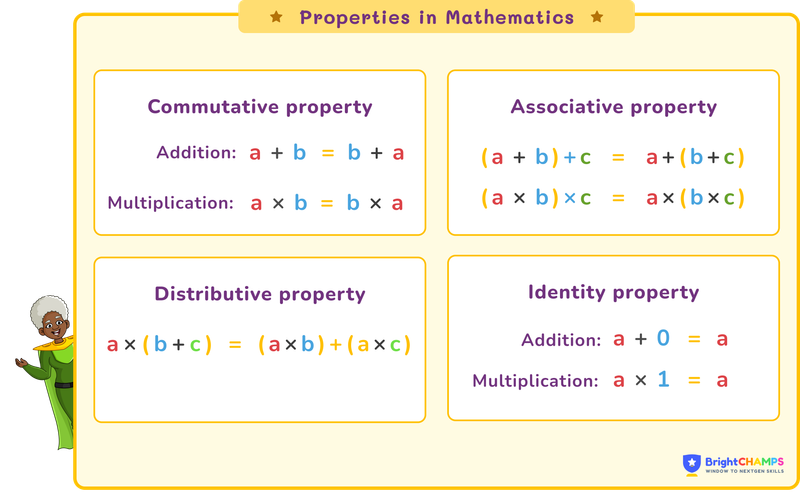
15814 Learners
Math
Mathematics is the science of order or structure used for counting or measuring any quantities. It is a subject of data, logical reasoning, shapes, numbers, and measurements. In everyday life, we use conceptual theories of math to resolve trivial problems. It has a few sub-topics such as arithmetic, geometry, trigonometry etc. that allow us to work on different problems based on our needs.
Share Post:
Trustpilot | Rated 4.7
1,292 reviews

A Basic Guide to Math and its Operations
Imagine a world without mathematics. Sounds chaotic right?
Galileo once said. “Mathematics is the language in which god wrote the universe”. Math is a key branch of science that includes geometry, arithmetic, and trigonometry. It has basic operations such as addition, subtraction, multiplication, and division.
Math concepts such as mean, median, probability, rational numbers, and integers help solve real-life problems. Topics such as the area of a triangle, the circumference of a circle, parallelograms, and types of triangles explain geometric shapes. At the same time, calculus concepts and Fibonacci sequences connect math to advanced studies and nature.
Learning what a function is and using tools like a multiplication chart builds strong problem-solving skills. Therefore, math trains the brain to think logically and opens doors to careers in science, engineering, and technology.
How to Learn Math
Mathematics is an important subject that helps students think logically, solve problems, and understand the world around them. It also covers essential topics such as numbers, shapes, measurements, and patterns, forming the foundation for advanced concepts in higher studies. Learning mathematics can build confidence, sharpen the mind, and develop analytical skills useful in everyday life and future careers.
- The program helps students strengthen their fundamentals in mathematics and statistics through interactive lessons and practice.
- Learn essential number topics such as integers and rational numbers, and understand clearly what an integer is and what a function is.
- Understand the area of a triangle formulas and the relationship between linear pairs of angles to strengthen your geometry skills.
- Develop a strong base in arithmetic using fun tools like multiplication charts and Roman numerals activities.
- Students can engage in interactive video sessions, regular tests, and performance analysis to track their improvement.
- Explore interesting patterns and number relations through Fibonacci sequences and their connections to geometric shapes and the natural world.

History of Math
Math has been a part of human existence ever since the ancient times. The earliest traces of math being used for calculation purposes can be traced back to the ancient Mesopotamia and Egyptian civilization.
Math was used simply as a tool in the ancient times to perform basic calculations such as counting, measuring etc. The evolution of math occurred with the change in applications of math.
Math generally uses a set of pre-defined formulas that solve particular problems. But some of the most basic and essential formulas were discovered hundreds or even thousands of years ago. The formula for calculations of volume was introduced by Archimedes around the 225 BCE.
Aryabhatha who is also known as the father of Indian mathematics used the number '0' as a placeholder in decimal numbers back in 499 CE. Similarly, there have been numerous other scientists who have made significant discoveries in the field of mathematics that helped the ancient math evolve into what it is today.
Some historical discoveries in the field of mathematics can be credited to mathematicians and scientists, such as Pythagoras discovered the Pythagorean theorem for a right-angled triangle around 530 BCE.
Similarly, Diophantus discovered Arithmetica which is basic methods of solving equations with unknowns around the year 250 CE. Al-Khwarizmi also discovered algebra around 820 CE, and numerous others contributed in helping math evolve over the years.
Then came a time in the 17th century when advanced calculations were needed to find out terms such as motion, velocity, gravity etc. To felicitate these new and more complex discoveries' math had to keep evolving.
Sir Isaac Newton discovered calculus, which made it possible to calculate motion of objects, gravitational forces and a lot more. Numerous more discoveries in the field of math made it possible to develop other forms of sciences too. Since pre-historic times, math has been evolving with the needs and requirements of the world.

Math as a Subject
Math is the most essential and fundamental subject that needs to be taught and learned, as it is used by everyone, regardless of their age or profession. The subject of mathematics requires skills such as critical thinking and problem-solving, which in turn enhance overall cognitive development.
Math is also a subject commonly used in our daily lives, as even the simplest calculations and measurements require the application of various forms of mathematics. Math is a part of academics from kindergarten. Math is applied in fields such as engineering, medicine, physics, and others. Pure and applied math are the branches of mathematics. Therefore, math is taught as a compulsory subject from the very beginning.

Importance of Mathematics
Humans use math every day, right from the moment we wake up to the moment we sleep again. Math has been embedded so deeply into our brains that, without even thinking about it. We use mathematical tools such as counting, multiplication, and addition throughout our daily lives. A few points are listed below that can help us understand the importance of mathematics better:
- Math is used to calculate dates, times, years, and other quantities. Without mathematics, it would be impossible to calculate any of these.
- All finance-related activities require some mathematics, such as budgeting, allocating funds, calculating taxes, or even basic tasks like counting money. All financial activities are incomplete without math.
- Apart from being a form of science itself, math has been the most crucial building block in the evolution of other sciences as well. For example, physics extensively uses math and its concepts while solving equations and form its own set of equations.
- Math is used to calculate and measure distances, heights, slopes, speed, and gravity, among other quantities, using branches of mathematics such as trigonometry and algebra. Graphical solutions for various problems are also created using math.

Fundamentals of Math
Math encompasses a wide range of concepts, which originate from the fundamental principles of mathematics. Fundamentals of mathematics are the basic terms and operations that can be performed using math.
A few math fundamentals are listed below:


Branches of Mathematics
Mathematics encompasses a wide range of topics, categorized under various branches of mathematics. These branches are closely connected and often overlap with each other. Even though there are numerous branches, they can be broadly classified into two categories:

- Pure Mathematics: This form of mathematics focuses primarily on concepts that have no immediate relation to real-life problems. For example, algebra, geometry, analysis, and topology, etc.
- Applied Mathematics: It deals with problems that are based on real-life applications. The branches of math under this concept focus on solving problems related to statistics, finance, probability etc.
Pure Mathematics Vs. Applied Mathematics
|
Pure Mathematics |
Applied Mathematics |
|
Algebra |
Calculus |
|
Geometry |
Trigonometry |
|
Topology |
|
|
Numerical Analysis |
|
|
Mathematical Analysis |
|

Important Math Formulas
Formulas are the building blocks of mathematics. They act as tools that make it possible to solve simple as well as complex mathematical problems. Some important formulas that are commonly used are mentioned below.

Symbols in Mathematics
In math, for representing operations, relations, concepts, and so on we use symbols. Each function has a unique symbol, let’s learn some of them.


Properties of Mathematics
Several properties in mathematics enable us to form relations between terms and enhance the process of solving equations or sets of numbers.
The four properties of math are:
- Commutative Property:
In addition: \(a + b = b + a\)
Example:\( 2 + 5 = 7\)
\(5 + 2 = 7\)
In multiplication: \(a × b = b × a\)
Example: \(2 × 5 = 10\)
\(5 × 2 = 10\).
- Associative Property:
\((a + b) + c = a + (b + c)\)
Example: \((2 + 5) + 3 = 2 + (5 + 3) = 10\)
\((a × b) × c = a × (b × c)\)
Example: \((2 × 2) × 5 = 2 × (2 × 5) = 20.\)
- Distributive Property:
For example: \(2 × (4 + 3) = (2 × 4) + (2 × 3) = 14.\)
- Identity Property:
In Addition: When adding 0 to a number, the sum remains the original number.
\(24 + 0 = 24\)
In multiplication: The product of multiplying a number by 1 is the number itself.
\(24 × 1 = 24\)


Math Calculator
Calculators are devices used to perform mathematical calculations. There are several types of calculators available based on the user's requirements, the most common being scientific calculators, graphing calculators, and programmable calculators.

Tips and Tricks for Learning Math
Math is a subject with numerous formulas, equations, and concepts, which makes it a tricky subject to get a grasp on, so here are a few tips and tricks that can help.
- Memorizing the basic properties and concepts of mathematics makes working more efficient.
- Regular practice can help you master math. Therefore, it is essential to practice regularly to fully understand math concepts. For practice, kids can use math worksheets, work on various problem-solving techniques, and engage in online math practice.
- For Geometry and Trigonometry, memorizing formulas is an effective way to apply them in calculations.
- In examinations, children often make mistakes in calculations. They should spend a quality amount of time revising the answer sheets.
- In many cases, children may get confused by symbols; it is advisable to pay close attention to them.
- For lower grades, online mock tests or online math practice can also help overcome mistakes.
- Teachers and parents should help students build a strong foundation in numbers, shapes, and simple operations before moving to advanced topics.
- Parents can relate math to daily activities like shopping or cooking to make learning fun and practical.
- Interactive learning keeps students engaged and helps them enjoy subjects like probability and arithmetic.

Common Mistakes in Math and How to Avoid Them
Math is considered to be a tough subject and there are a few mistakes that are committed often while solving mathematical problems. In this section, we will learn about some common mistakes that are made while solving math and the ways to avoid them.

Real-World Applications of Math
Math is everywhere from home to school or work. As we use math a lot, it's hard for us to realize how often we use it. Let’s see how we use math in daily life.
1. Finance

1. Finance
Finance is all about how we manage our money, interest, rate calculation and so on. Math is the base of finance. So for good finance management, we should learn basic math.
2. Engineering

2. Engineering
Practicing math helps us develop problem-solving skills. These skills help engineers solve complex problems that require logical thinking. In engineering, the branches of mathematics used are algebra, trigonometry, geometry, measurements, etc.
3. Cooking

3. Cooking
Measurement of ingredients is very important when cooking. And measurement is all about numbers and units.

Career Opportunities in Mathematics
From all we learn, we know that math has an impact on the real world. So there are ample career opportunities for a person with a strong foundation in mathematics. Let's see some interesting career opportunities in mathematics.
- Mathematics teacher
- Accountant
- Computer programmer
- Financial analyst
- Finance planner
- Engineer
- Auditor
- Statistician
- Economist

Solved Examples in Math

Problem 1
Find the sum of 525 and 354.

The sum is 879.
Explanation
To find the sum of 525 and 354, we need to add them together. That is, 525 + 354 = 879.

Problem 2
What is fifteen percent of 300?

15% of 300 is 45.
Explanation
The formula to calculate percentage is given value / total value × 100
Here, 15 / 100 × 300 = 45

Problem 3
The length of a side of a square is 4, find the area of the square.

The area of a square is 16.
Explanation
Area of a square is a2
Therefore, the area is 42 = 16.

Problem 4
Find the product of 55 × 6.

The product is 330.
Explanation
55 × 6 = (50 × 6) + (5 × 6)
= 300 + 30 = 330.

Problem 5
Find the value of x in 3x + 5 = 20.

The value of x is 5.
Explanation
3x + 5 = 20
3x = 20 - 5
3x = 15
x = 15 / 3 = 5.


FAQs about Math
1.What are the basic operations of math?
2.Who found zero?
3.What are the branches of mathematics?
4.What is calculus?
5.What are the roles of mathematics in finance?
6.What are the 4 types of math?
7.Why is math important?
8.What is the full form of BODMAS?
9.What is equal to in maths?
10.Who founded maths?
11.What is sequence in maths?
12.What is the best stage to learn maths?
13.What is symbol in math?

Explore More Topics Under Numbers
![Important Math Links Icon]() Prime Numbers
Prime Numbers
![Important Math Links Icon]() LCM
LCM

Explore More Topics Under Multiplication Tables
![Important Math Links Icon]() Times Table
Times Table

Explore More Topics Under Algebra
![Important Math Links Icon]() Cube Root
Cube Root
![Important Math Links Icon]() Square Root
Square Root


Hiralee Lalitkumar Makwana
About the Author
Hiralee Lalitkumar Makwana has almost two years of teaching experience. She is a number ninja as she loves numbers. Her interest in numbers can be seen in the way she cracks math puzzles and hidden patterns.
Fun Fact
: She loves to read number jokes and games.




